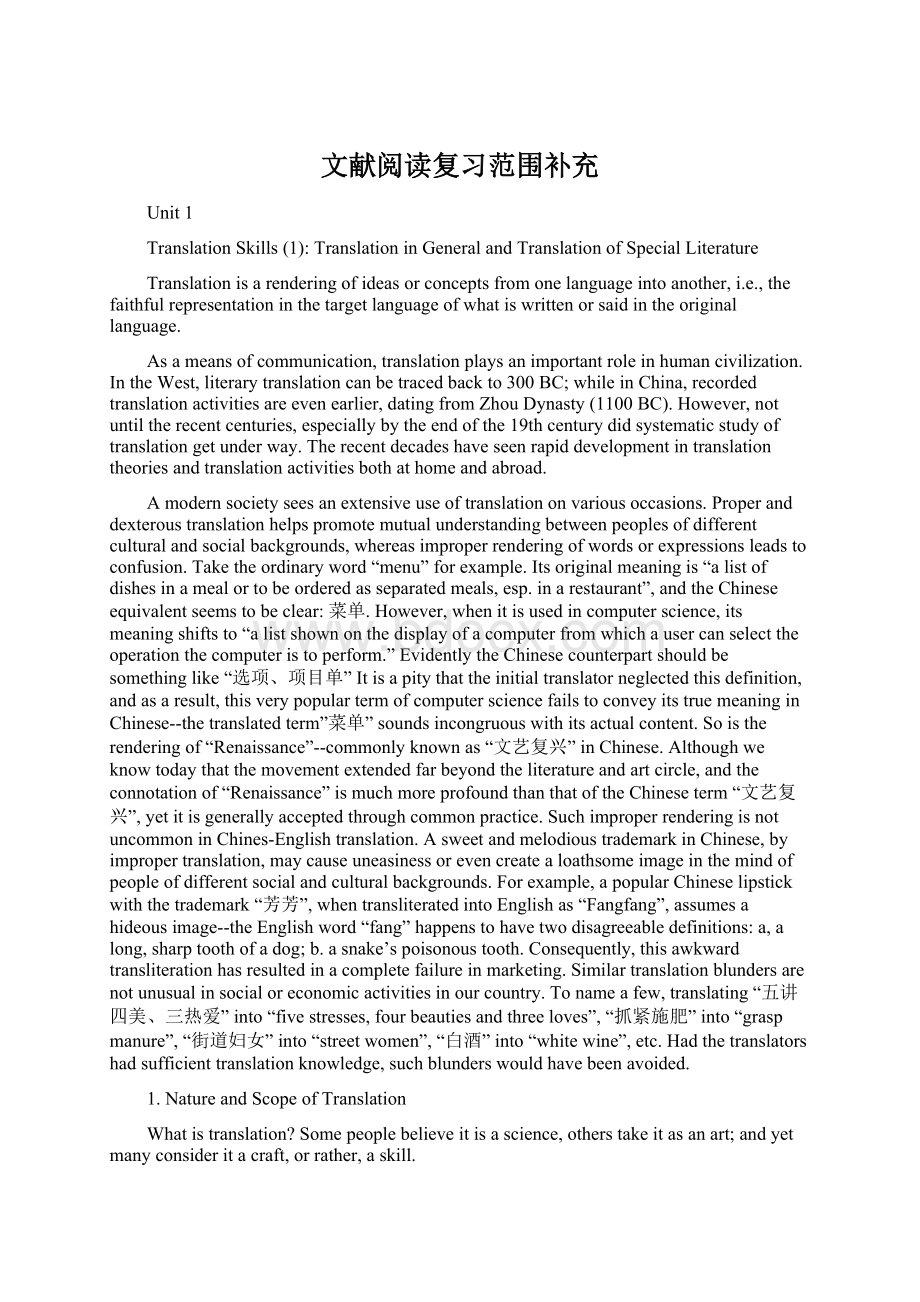文献阅读复习范围补充文档格式.docx
《文献阅读复习范围补充文档格式.docx》由会员分享,可在线阅读,更多相关《文献阅读复习范围补充文档格式.docx(17页珍藏版)》请在冰豆网上搜索。

Translationisarenderingofideasorconceptsfromonelanguageintoanother,i.e.,thefaithfulrepresentationinthetargetlanguageofwhatiswrittenorsaidintheoriginallanguage.
Asameansofcommunication,translationplaysanimportantroleinhumancivilization.IntheWest,literarytranslationcanbetracedbackto300BC;
whileinChina,recordedtranslationactivitiesareevenearlier,datingfromZhouDynasty(1100BC).However,notuntiltherecentcenturies,especiallybytheendofthe19thcenturydidsystematicstudyoftranslationgetunderway.Therecentdecadeshaveseenrapiddevelopmentintranslationtheoriesandtranslationactivitiesbothathomeandabroad.
Amodernsocietyseesanextensiveuseoftranslationonvariousoccasions.Properanddexteroustranslationhelpspromotemutualunderstandingbetweenpeoplesofdifferentculturalandsocialbackgrounds,whereasimproperrenderingofwordsorexpressionsleadstoconfusion.Taketheordinaryword“menu”forexample.Itsoriginalmeaningis“alistofdishesinamealortobeorderedasseparatedmeals,esp.inarestaurant”,andtheChineseequivalentseemstobeclear:
菜单.However,whenitisusedincomputerscience,itsmeaningshiftsto“alistshownonthedisplayofacomputerfromwhichausercanselecttheoperationthecomputeristoperform.”EvidentlytheChinesecounterpartshouldbesomethinglike“选项、项目单”Itisapitythattheinitialtranslatorneglectedthisdefinition,andasaresult,thisverypopulartermofcomputersciencefailstoconveyitstruemeaninginChinese--thetranslatedterm”菜单”soundsincongruouswithitsactualcontent.Soistherenderingof“Renaissance”--commonlyknownas“文艺复兴”inChinese.Althoughweknowtodaythatthemovementextendedfarbeyondtheliteratureandartcircle,andtheconnotationof“Renaissance”ismuchmoreprofoundthanthatoftheChineseterm“文艺复兴”,yetitisgenerallyacceptedthroughcommonpractice.SuchimproperrenderingisnotuncommoninChines-Englishtranslation.AsweetandmelodioustrademarkinChinese,byimpropertranslation,maycauseuneasinessorevencreatealoathsomeimageinthemindofpeopleofdifferentsocialandculturalbackgrounds.Forexample,apopularChineselipstickwiththetrademark“芳芳”,whentransliteratedintoEnglishas“Fangfang”,assumesahideousimage--theEnglishword“fang”happenstohavetwodisagreeabledefinitions:
a,along,sharptoothofadog;
b.asnake’spoisonoustooth.Consequently,thisawkwardtransliterationhasresultedinacompletefailureinmarketing.Similartranslationblundersarenotunusualinsocialoreconomicactivitiesinourcountry.Tonameafew,translating“五讲四美、三热爱”into“fivestresses,fourbeautiesandthreeloves”,“抓紧施肥”into“graspmanure”,“街道妇女”into“streetwomen”,“白酒”into“whitewine”,etc.Hadthetranslatorshadsufficienttranslationknowledge,suchblunderswouldhavebeenavoided.
1.NatureandScopeofTranslation
Whatistranslation?
Somepeoplebelieveitisascience,otherstakeitasanart;
andyetmanyconsideritacraft,orrather,askill.
Ofthesevarieddefinitions,whichoneholdstrueforourpurpose?
Theanswerdependsonhowweunderstandorinterprettheword“translation”,fortheveryword“translation”itselfisambiguous.AndtheChineseequivalentfanyisoundsevenfuzzier.Fanyi,inChinese,mayeitherstandforasubjectinthecurriculum,ajobpeopleengagein,apieceofliterarywork,orthetranslatingorinterpretingworkitself.Sometimes,fanyimayevenrefertothetranslatororinterpreterhimself/herself.
Iftheword“translation”referstoasubject,namely,thestudyoftranslationtheoryandskills,itisnodoubtascience,justasanysubjectis,withitsownrules,lawsandprinciplesforthetranslatorstoobserve;
however,ifitreferstosomespecificpiecesoftranslation,thenitismorelikeanart,witheachpieceofthemmanifestingitsowncharmsandstyleinthecreativehandsofthetranslator;
whereas,ifitreferstoaprocess,inwhichsomethingistranslated,thenwemayregarditasacraftorskill.Forunlikeanybranchofnaturalscience,theprocessoftranslationhasitsownnature,andnoneofitsrulesandprinciplesareuniversallyapplicable.Therefore,itentailsalotofpractice,andparticularcraftsmanshipandskillsarereflectedbythetouchesofdifferenttranslators.
Translationcoversaverybroadrange.Intermsoflanguages,itcanbedividedintotwocategories:
fromnativelanguagesintoforeignlanguagesandviceversa;
intermsofthemode,itcanbedividedintooralinterpretationandwrittentranslation;
intermsofmaterialstobetranslated,therearetranslationofscientificmaterials,translationofliteraryworkssuchasnovels,stories,prose,poetry,drama,etc.,translationofpoliticalessayssuchastreatisesonsocialproblems,repons,speeches,etc.,andtranslationofpracticalwriting(asofficialdocuments,contractsandagreements,notices,receipts,etc.);
intermsofdisposal,itcanbeeitherfull-texttranslation,abridgedtranslationoradaptedtranslation.
2.PrinciplesorCriteriaofTranslation
Theso-calledprinciplesandcriteriaoftranslationareactuallythetwosidesofthesamecoin.Thatis,onthepartofthetranslator,heorsheshouldfollowthemwhiletranslating;
whereasonthepartofthereaderorcritic,heorshemayusetheprinciplesandcriteriatoevaluatetranslationworks.WheneverprinciplesorcriteriaoftranslationareunderdiscussioninChina,YanFu’s“three-characterguide”--xin,da,ya,namely,“faithfulness(信),expressiveness(达),andelegance(雅)”,whichwasfirstproposedin1898,wouldevokecontroversy.
Inthepastdecades,Mr.Yan’sprinciplehasalwaysbeenregardedasaplumb-lineformeasuringtheprofessionalleveloftranslationandagoalfortranslatorstostriveafter.However,intheapplicationofthisprinciple,peoplecometofindsomeunsatisfactoryaspectsofthethree-characterguideandhaveputforewordavarietyofnewstandardsorcriteriaoftranslation.
Despiteavarietyofopinions,twocriteriaarealmostunanimouslyacceptedbyall,namely,thecriterionoffaithfulness/accuracy(忠实/准确)andthatofsmoothness(流畅).Wemayalsotakethesetwocriteriaastheprinciplesofscientificliteraturetranslation.Byfaithfulness/accuracy,wemeantobefaithfulnotonlytotheoriginalcontents,totheoriginalmeaningandviews,butalsototheoriginalformandstyle.Bysmoothness,wemeannotonlyeasyandreadablerendering,butalsoidiomaticexpressioninthetargetlanguage,freefromstiffformulaandmechanicalcopyingfromdictionaries.
3.LiteralTranslationandFreeTranslation
Theprocessoftranslationconsistsoftwophases:
comprehensionandexpression.Generallyspeaking,comprehensionisofforemostimportance,andexpressionisthenaturalconsequenceofthoroughcomprehension.However,inthepracticewemayfindthatnowandthensomewordsorphrasesintheirusualsensesareverydifficulttodealwithbecauseofthedisparitybetweenEnglishandChinese.Inthiscase,wehavetoresorttosomespecialmeansoftranslation.Literaltranslation(直译)andfreetranslation(意译)aretwodynamicapproachesindealingwithsuchawkwardsituations.
Theso-calledliteraltranslation,superficiallyspeaking,means“nottoaltertheoriginalwordsandsentences”;
strictlyspeaking,itstrives“tokeepthesentimentsandstyleoftheoriginal.”Ittakessentencesasitsbasicunitsandtakesthewholetext(discourse)intoconsiderationatthesametimeinthecourseoftranslation.Furthermore,itstrivestoreproduceboththeideologicalcontentandthestyleoftheoriginalworksandretainsasmuchaspossiblethefiguresofspeech.TherearequitealotofexamplesofsuccessfulliteraltranslationthathavebeenadoptedasidiomaticChineseexpressions.Forexample,crocodile’stears(鳄鱼的眼泪),armedtotheteeth(武装到牙齿),chainreaction(连锁反应),gentlemen’sagreement(君子协定),andsoon.Similarly,someChineseidiomsalsofindtheirEnglishcounterpartsthroughliteraltranslation.Forexample,纸老虎(papertiger),一国两制(onecountry,twosystems),andsoon.
Freetranslationisanalternativeapproachwhichisusedmainlytoconveythemeaningandspiritoftheoriginalwithouttryingtoreproduceitssentencepatternsorfiguresofspeech.Thisapproachismostfrequentlyadoptedwhenitisreallyimpossibleforthetranslatortodoliteraltranslation.Forexample:
Adam’sApple喉结
atsixesandsevens乱七八槽
Itrainscatsanddogs.大雨滂沱
Don’tcrossthebridgetillyougettoit.不必担心过早。
(不必自寻烦恼。
)
Doyouseeanygreeninmyeye?
你以为我是幼稚可欺的吗?
TheaboveEnglishexpressionsandsentencescannotbetranslatedliterally,otherwise,theChineserenderingwouldmakenosense,letaloneconveytheoriginalmeaning.
Literaltranslationandfreetranslation,likeanytranslationtechniques,arebothrestrictedinapplication.Inotherwords,thereisnoabsolute“literal”orentirely“free”versioninthepracticeoftranslation,andoveremphasizingeitherofthemwouldresultinridiculousconsequences.
Intheapplicationofliteraltranslation,weshouldendeavortoridourselvesofstiffpatternsandrigidadherencetotranslationrules,tryingtobeflexible;
whileinthepracticeoffreetranslation,weshouldbecautiousofsubjectivity,avoidinggroundlessaffirmationorarbitraryfabrication.Inactualpractice,weoftenalternateorcombinethesetwoapproachesinsteadstickingtoeither.
4.TranslationTechniques
Speakingoftranslationtechniques,wedifferfromthosewhotendtoignorethem,ordismissthemlightlyassomethinginconsequential.Ontheoth